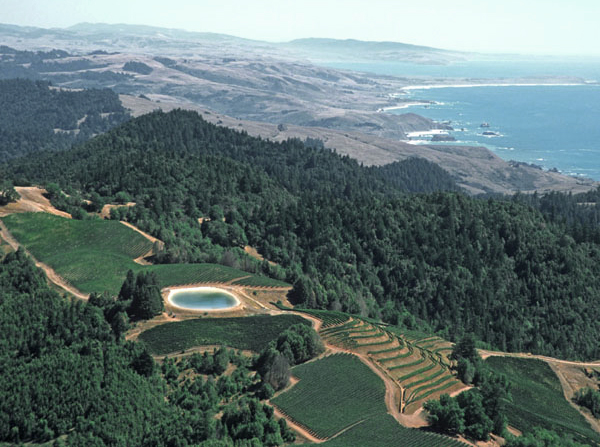Much is made of being a family-owned winery. So much that even some of the huge companies like Kendall-Jackson are happy to tell you they are a family winery. There's a organization, Family Winemakers of California, that consists of one-man operations up through Kendall-Jackson. So yes, KJ is family-owned, but maybe not family-sized.
Many consumers feel better about supporting local family producers just as many feel better if they know the grapes were organically farmed. And the romance of winemaking is tossed out the window when you think of large scale operations where the winemaker spends most of their time in front of a computer screen "making" their wine rather than on the sorting table and the press.
Is smaller better? Is family-owned better than corporate-owned? That can be debated as larger outfits can theoretically have more resources to get better fruit and make better wine. They are more likely to make consistent wine year after year so you know what you're getting. They can also be more focused on the bottom-line for the next quarter rather than the product (look where that got the Big Three auto companies).
So who are the big ones?
 |
| "Chateau Constellation" - Constellation Brands headquarters in NY |
Gallo
This famous family has lots of different labels. It used to be if the label said Modesto then you knew it was Gallo (they are headquartered in Modesto CA). Now they have operations elsewhere including a huge presence in Sonoma County.
Some of their well-known wines are Andé, Barefoot Cellars, Frei Brothers, Gallo Sonoma, Louis Martini, MacMurray Ranch, Tisdale, and Turning Leaf. Gallo has over 50 labels and brands. (By "label" I mean the wines don't come from an independent winery but made in some sort of co-op facility usually; a "real" winery would be Louis Martini, for example).
 |
| Yes, this one is owned by Gallo |
The Wine Group
A generic name for a San Francisco-based company that started life as Coca Cola's venture into the wine business. Best-known for Franzia box wine.
Some other well-known properties are Almaden and Concannon
Constellation Brands
Constellation is headquartered in upstate NY.
Well-known brands include Blackstone, Clos du Bois, Columbia, Franciscan, Ravenswood, Robert Mondavi, and Simi plus dozens of others around the world.
Diageo
They are headquartered in London and are big players in the spirits market.
Some of their big names in wine are Sterling, Beaulieu and Rosenblum.
BTW, if you're looking for a job their website currently shows an opening for a Liquid Innovation Manager in Connecticut!
Treasury Wine Estates
Treasury was spun off from Fosters when they decided to concentrate on their beer biz. Treasury owns about 50 brands from around the world including quite a few in Australia and New Zealand, as you might expect.
Some of the bigger U.S. names are Asti, Beringer, Chateau St Jean, Meridian, Stags Leap, and St Clement.
Trinchero
Based in Napa they started with the Sutter Home White Zinfandel cash.
Other well-known brands are Folie a Deux, Montevina, Napa Cellars, Trinchero, and Trinity Oaks.
Bronco
Run by the Franzia family, relatives of the Gallos, with about 100 different labels.
Known for Charles Shaw, Forestville, Napa Creek, Napa Ridge, Red Truck, Robert Hall, and Rutherford Vintners. Fred Franzia was in a bit of trouble awhile ago for using "Napa" in winery label names when the grapes weren't actually grown in Napa.
From personal experience I've seen where Constellation Brands and Treasury Wine Estates are what I'd call true corporations. In fact, when Treasury first split from Fosters their new web page said something like, "One foot in the vineyard, one in the board room." Luckily, that motto is long gone. It seems that Constellation, Treasury, along with Diageo, seem to be about owning fairly autonomous wineries rather than just having a bunch of labels aimed at different market segments (that is, they are all "real" wineries).
Other big players in the wine business are Brown-Forman, Jackson, and Ste Michelle.
So is smaller better? I can't say. Does buying from one of the local little guys make me feel better? Yes, but that doesn't stop me from purchasing Louis Martini, Simi or St. Jean wines, for instance.
I have watched the change in some of these wineries from local ownership to being swallowed up by large companies--brands like Chateau St Jean, Clos du Bois, Gary Farrell, Folie a Deux, Franciscan, Kenwood, Raveswood, Simi, and others. Did they change over time? Mostly yes, but maybe they would have anyway. Was it for the worse? Sometimes. Especially, it seems, in some of their cheaper "grocery store" wines. I'd guess that's where the accounting-types have their greatest influence on maximizing profits.
In the last year wine sales were up significantly. Per an industry group half of that growth went to Gallo, The Wine Group, and Constellation Brands.












